A prominent leader in the American civil rights movement, Martin Luther King Jr. was brutally murdered in Memphis, Tennessee on April 4, 1968.
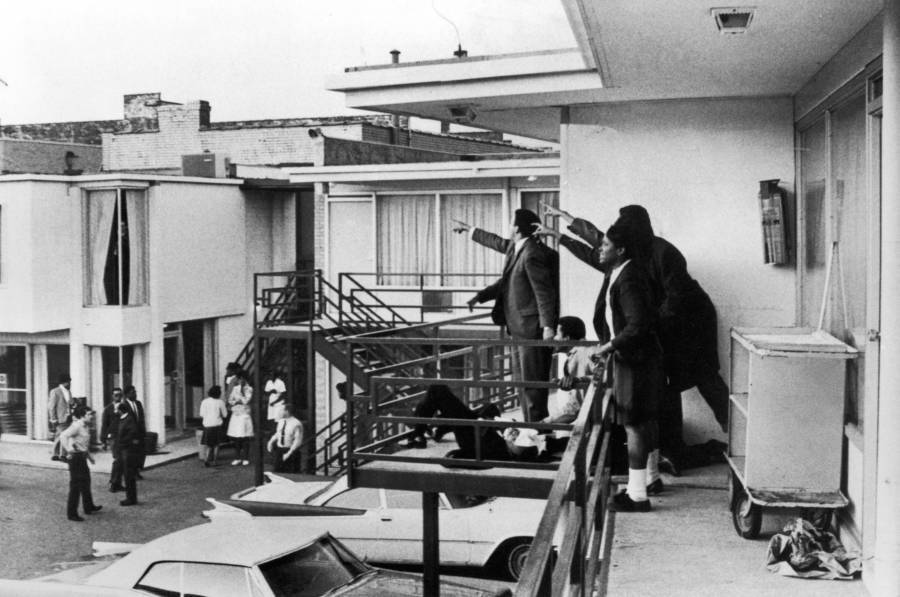
Joseph Louw/The LIFE Images Collection/Getty ImagesIn one of the most famous photos from Martin Luther King Jr.’s assassination, several of King’s fellow civil rights activists point in the direction of the assassin as King, fatally shot, lies bleeding at their feet.
On a spring night in 1968, the world changed forever. Televisions buzzed and radios crackled as the news spread across the country: Martin Luther King Jr., the civil rights leader who’d given the iconic “I Have a Dream” speech in Washington, D.C. in 1963 and marched at Selma in 1965, was dead.
King had been assassinated in Memphis, Tennessee, killed at the age of 39 by a gunman who had fled into the night. Riots broke out in 100 American cities in the days that followed, and some 27,000 people were arrested. Grief and anger ricocheted across every corner of the country, and King’s murder stands as one of the most pivotal events of the 20th century to this day.
Read on to learn everything you need to know about the tragic assassination, from Martin Luther King Jr.’s death at the Lorraine Motel, to the hunt for the gunman, to the questions that have swirled around the event ever since.
When Was MLK Assassinated?
Martin Luther King Jr., the civil rights leader at the forefront of the American civil rights movement, was assassinated at 6:01 p.m. on April 4, 1968.
King had been preparing to leave for dinner with Samuel Billy Kyles, a minister in Memphis, Tennessee. As Kyles later told The New York Times, he, King, and others spent about an hour in King’s hotel room enjoying some “preacher talk.” As the dinner hour neared, Kyles picked out a necktie for King and accompanied him onto the balcony of his hotel at around 5:45 p.m.
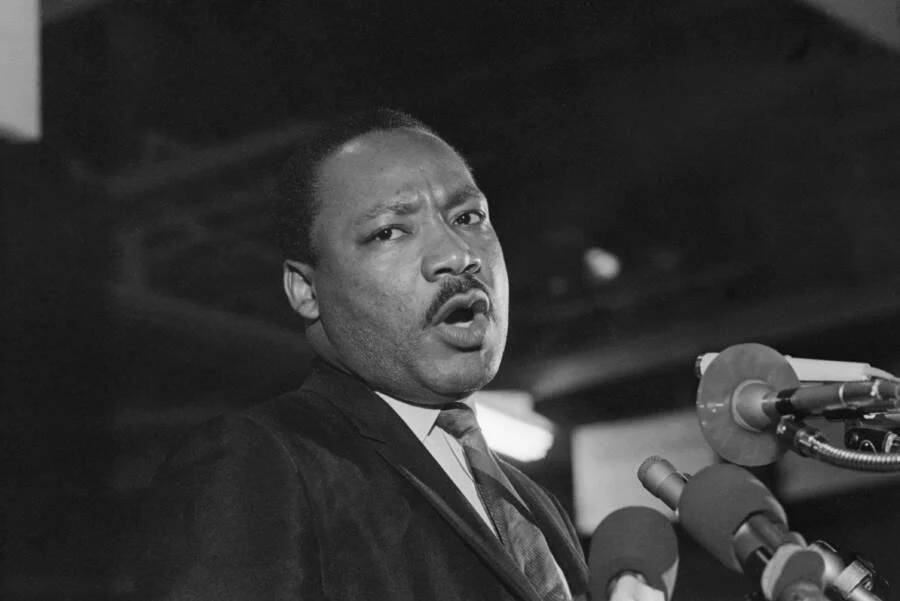
Bettmann/Contributor via Getty ImagesMartin Luther King Jr. giving his last speech on April 3, 1968, known as the “I’ve Been to the Mountaintop” speech.
They were running late — dinner was supposed to start at 6 p.m. — so Kyles remembered trying to hurry King into the white Cadillac that was waiting for them below. King, though, took a moment to talk to several people who were waiting for him below in the courtyard. Then, Kyles heard the shot.
It sounded like “kuh-PIE-yah!” Kyles recalled.
Where Was MLK Shot?
Martin Luther King Jr.’s assassination took place at the Lorraine Motel in Memphis, Tennessee. King was staying in Room 306, and he was fatally shot near his door on the motel’s second-floor balcony.
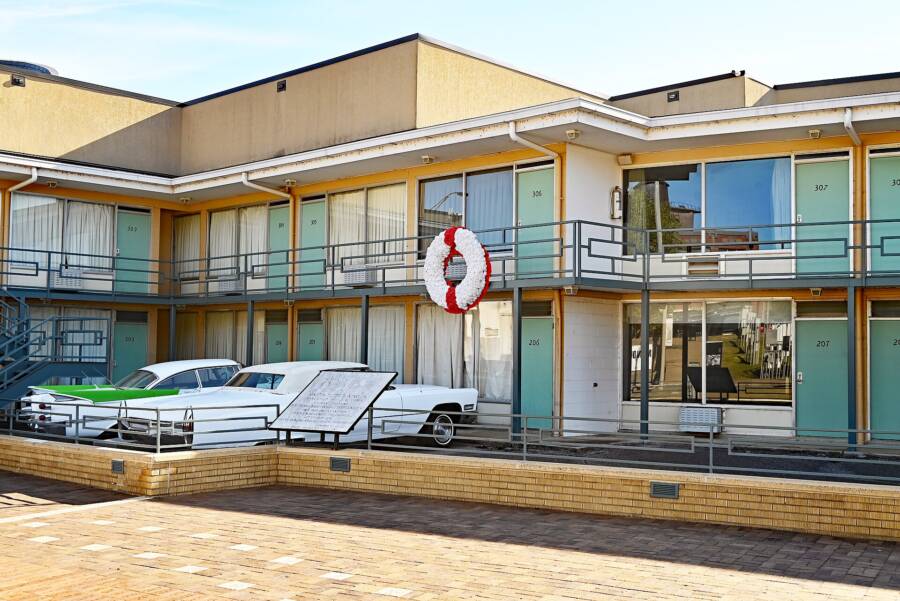
Bubba73/Wikimedia CommonsThe Lorraine Motel today, which is now part of the National Civil Rights Museum in Memphis.
King and other members of the Southern Christian Leadership Conference (SCLC) were in Memphis to support a local sanitation workers’ strike. Though King was focused on planning a march in Washington, D.C., the “Poor People’s Campaign,” he agreed to come to Memphis to support the 1,300 Black city sanitation workers who were striking. They were paid poorly, and were demanding a wage increase and better working conditions.
On the night before his death, Martin Luther King Jr. gave a speech at the Mason Temple in Memphis in support of the strikers. King’s sermon — largely off the cuff — is now known as the “I’ve Been to the Mountaintop” speech. It would be the last speech he ever gave, and in the days following his assassination, it struck many people as prophetic.
“We’ve got some difficult days ahead,” King told the crowd. “But it really doesn’t matter with me now, because I’ve been to the mountaintop… Like anybody, I would like to live a long life. Longevity has its place. But I’m not concerned about that now… I’ve seen the Promised Land. I may not get there with you. But I want you to know tonight, that we, as a people, will get to the Promised Land! … I’m not worried about anything. I’m not fearing any man! Mine eyes have seen the glory of the coming of the Lord!”
When Did Martin Luther King Die?
Martin Luther King Jr. was shot at 6:01 p.m. on April 4, 1968. But even though he was mortally wounded, he didn’t die right away. King had a pulse, and his mouth moved, although he did not speak. As the men on the balcony with King attempted to make him comfortable, covering him with a blanket and placing his head on a pillow, King quickly lost consciousness.
The shooting was radioed to police headquarters just moments later — there had also been several police officers stationed across the street from King’s hotel who witnessed the shooting and ran to the scene — and King was loaded into an ambulance at 6:09 p.m. St. Joseph’s Hospital was about 1.9 miles away, and the ambulance made the trip in roughly four minutes.
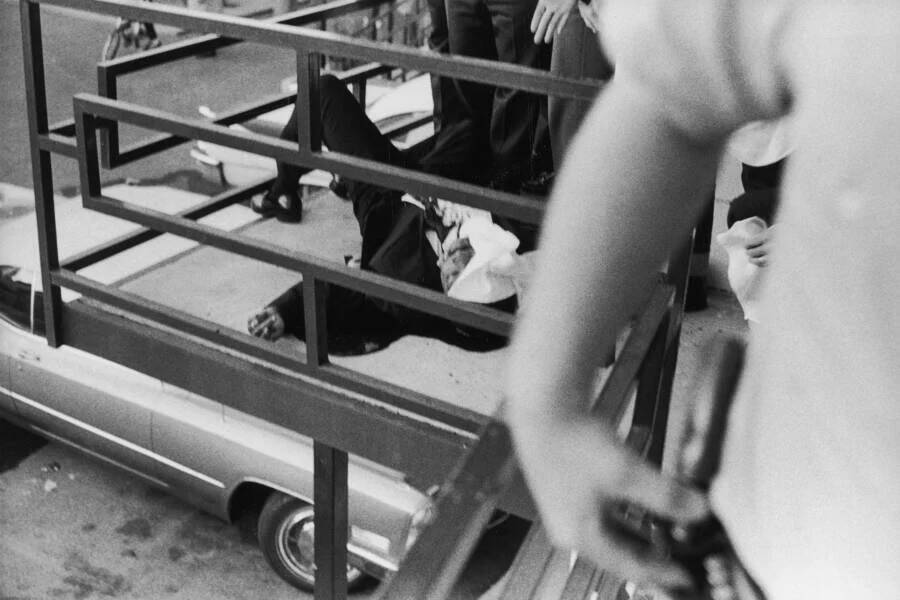
Joseph Louw/The LIFE Images Collection/Getty ImagesMartin Luther King Jr., moments after he was fatally shot.
Though King was still clinging to life, doctors at St. Joseph’s Hospital were ultimately unable to save him. He was pronounced dead at 7:05 p.m.
How Did Martin Luther King Jr. Die?
When Martin Luther King Jr. was shot, the bullet entered on the right side of his face and neck. An autopsy found that the bullet had shattered King’s right jawbone, then traveled through the right side of his neck, injuring the external jugular vein, the vertebral artery, and the subclavian artery. The bullet then transected the spinal cord and lodged in the left shoulder blade.
King’s official cause of death was hemodynamic collapse from hemorrhagic shock. Dr. Jerry Francisco, the medical examiner who conducted King’s autopsy, later put it in simpler terms. King had died, he said, from a “gunshot wound to the chin and neck with a total transaction of the lower cervical and upper thoracic spinal cord and other structures of the neck.”
Martin Luther King Jr. was just 39 years old.
What Was The Reaction To Martin Luther King’s Death In The United States?
News of Martin Luther King Jr.’s assassination spread quickly throughout the country. Though most people would have heard reports on television or the radio, a crowd in Indianapolis, Indiana, learned of King’s murder from Robert F. Kennedy, who was in the city during his presidential campaign. (Kennedy, of course, would be assassinated himself just months later.)
Speaking to a mostly Black audience, Kennedy announced the news to gasps and screams, then said: “For those of you who are Black and are tempted to be filled with hatred and distrust at the injustice of such an act, against all white people, I can only say that I feel in my own heart the same kind of feeling. I had a member of my family killed, but he was killed by a white man. But we have to make an effort in the United States, we have to make an effort to understand, to go beyond these rather difficult times.”
Though things stayed relatively calm in Indianapolis that night, riots broke out in over 100 other cities. Some 3,500 people were injured, 40 were killed, and some 27,000 people were arrested, including 6,100 in Washington, D.C.
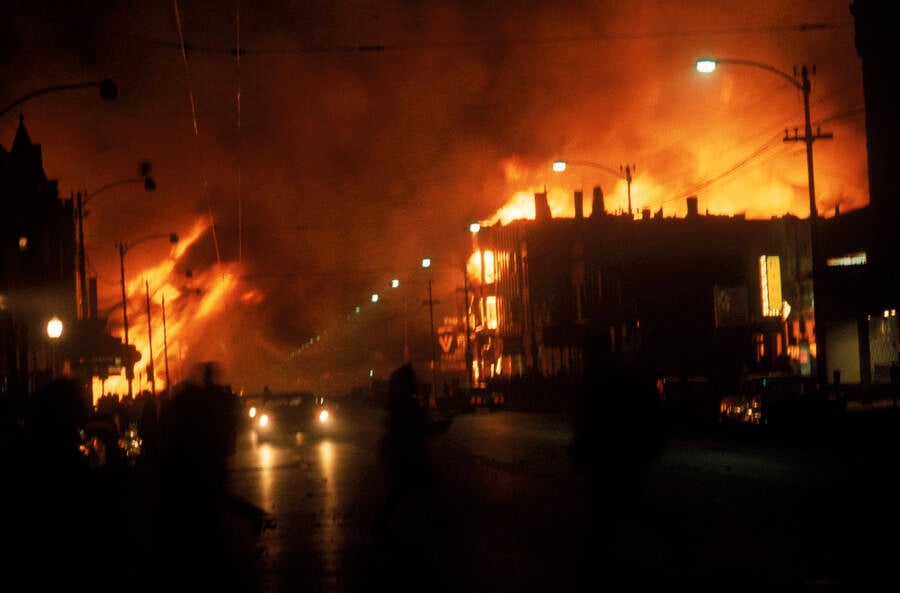
Lee Balterman/The LIFE Picture Collection/Getty ImagesA riot following the assassination of Martin Luther King Jr.
Inside the anger and despair that the rioters felt was a question: Who had killed Martin Luther King Jr.? But even though investigators quickly identified a suspect, it took them over two months to track him down.
Who Killed MLK?
After Martin Luther King Jr. was assassinated, investigators found a Remington .30-06 hunting rifle near a boarding house across the street from the Lorraine Motel. Authorities then found fingerprints on the gun. They also determined that a white Mustang spotted leaving the scene was registered to a Mr. Eric Galt, and the gun had been purchased by a Mr. Harvey Lowmyer. These were known aliases of a criminal named James Earl Ray.
The fingerprints on the gun were Ray’s as well.
But tracking Ray down was no easy feat. The alleged assassin had escaped from Missouri State Penitentiary in 1967, where he’d been serving a 20-year sentence. As investigators later determined, he’d quickly left the country after Martin Luther King Jr.’s assassination, crossing the Canadian border on April 6, 1968, and then making his way across the Atlantic to Europe.
In June 1968, however, investigators finally caught up with Ray. He was arrested in London, and later pleaded guilty to shooting King on March 10, 1969. He was sentenced to 99 years in prison for the crime.
So who exactly was James Earl Ray?
Who Was James Earl Ray?
Born on March 10, 1928, in Alton, Illinois, most of James Earl Ray’s life was marked by ineptitude. After enlisting in the U.S. Army during World War II, Ray was discharged for “ineptness and lack of adaptability to military service.”
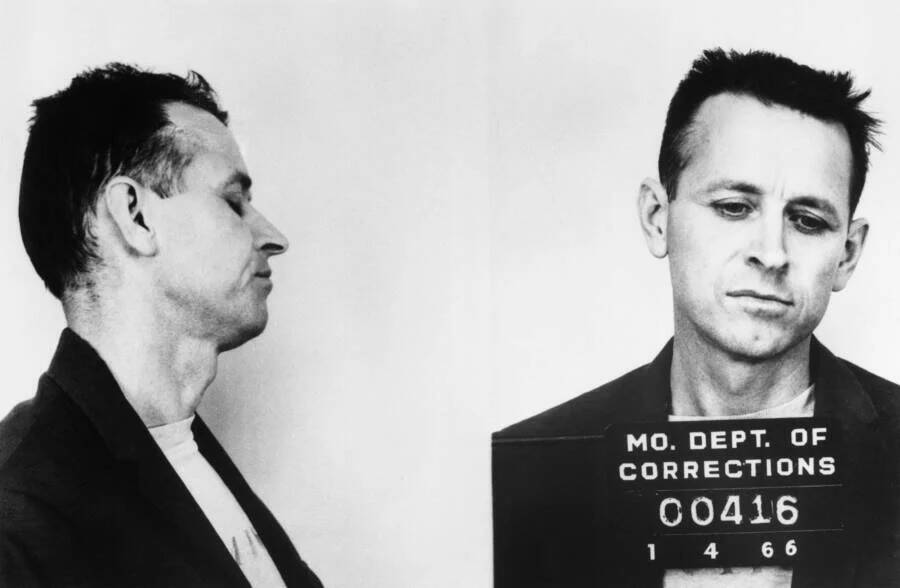
Bettmann/Getty ImagesJames Earl Ray’s mugshot in 1966, two years before Martin Luther King Jr.’s death.
Afterward, he followed in the footsteps of several others in his family and embarked on a life of crime. But Ray proved to be inept here, too. The first time that Ray tried to rob someone, he left behind his identification. And when he tried to rob a taxi driver at gunpoint — for $11 — Ray led the police into a dead-end alleyway, where they quickly arrested him.
Ray committed more crimes in the 1950s and, in 1959, was sentenced to 20 years for holding up a grocery store in St. Louis. He managed to escape in 1967, and wound his way through Canada, Alabama, Mexico, and Los Angeles, before making his way to Memphis, Tennessee, in April 1968.
There, investigators alleged, James Earl Ray had killed Martin Luther King Jr. But to understand Ray’s purported motives, you have to understand the role Martin Luther King Jr. had grown to play in American society.
Who Was Martin Luther King?
Born on Jan. 15, 1929 in Atlanta, Georgia, to Martin Luther King Sr. and Alberta Williams King, King grew up in a comfortable, middle-class Black family. However, he still experienced segregation and racism in Jim Crow America.
King later attended Morehouse College, Crozer Theological Seminary, and Boston University. He met his wife, Coretta Scott, in Boston, and the couple soon moved to Montgomery, Alabama, where King became the pastor of the Dexter Avenue Baptist Church. In 1955, King became the leader of the Montgomery bus boycott, a protest against segregation on the city’s buses.
This marked the start of King’s leadership role in the civil rights movement.
What Did Martin Luther King Jr. Do?
Between 1955 and his death in 1968, Martin Luther King Jr. employed several tactics to move the civil rights movement forward. He helped found the Southern Christian Leadership Conference (SCLC) in 1957, which embraced the idea of nonviolent protests, and oversaw boycotts, sit-ins, and marches. King, a talented orator, also gave iconic speeches about civil rights, most famously his 1963 “I Have a Dream” speech in Washington, D.C.
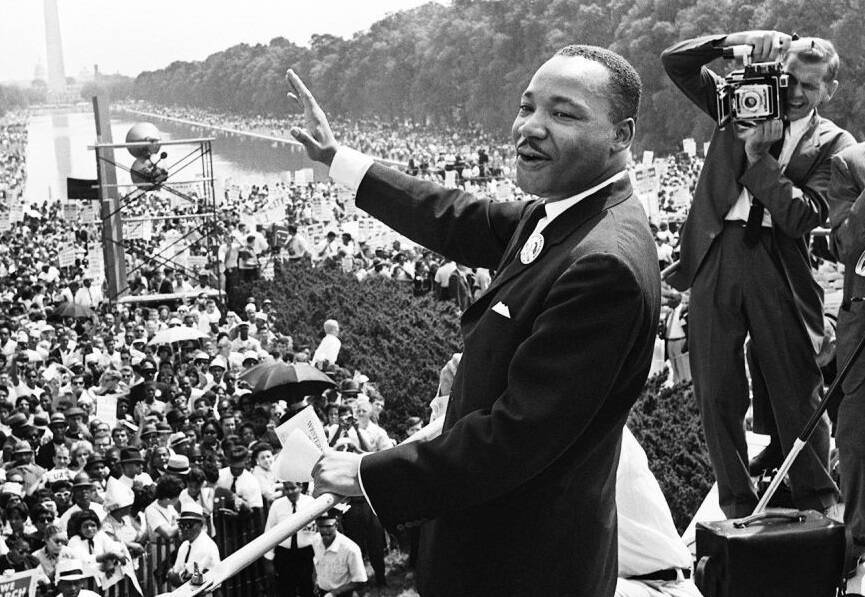
AFP/Getty ImagesMartin Luther King Jr. giving his famous “I Have a Dream” speech in Washington, D.C. 1963.
This made King a public figure in the United States — and a controversial one. The FBI tried to expose King’s dark side to the public, including his extramarital affairs, and some Black activists like Malcolm X thought that King’s nonviolence was the wrong approach to address racism.
King’s house was dynamited during the Montgomery bus boycott, and he was nearly stabbed to death in 1958 by a mentally disturbed woman named Izola Ware Curry. Just before he flew to Memphis in April 1968, Martin Luther King Jr.’s flight was delayed because of a bomb threat — which led him to tell his family that he thought a “price” had been put on his head.
Why Did James Earl Ray Kill Martin Luther King Jr.?
So why did James Earl Ray shoot Martin Luther King Jr.? In the aftermath of Martin Luther King Jr.’s death, those who knew Ray thought that the answer was perfectly clear: Ray was a racist who hated what King stood for.
Ray’s fellow inmates remembered him flying into a rage when King appeared on TV, and exclaiming: “Somebody’s got to get him. If I ever get to the streets, I am going to kill him.” Ray similarly told his brother Jerry that he wanted to kill King, and that he believed that George Wallace, the segregationist governor of Alabama who was running for president, would eventually pardon him. Jerry also recalled that his brother admired Adolf Hitler and wanted the United States to be an “all-white country.”
In the end, the House Select Committee on Assassinations speculated that James Earl Ray had killed King in order to collect a $50,000 bounty that had been offered by George Wallace supporters in St. Louis.
But even though Ray initially pleaded guilty to assassinating King, he attempted to withdraw his confession just 72 hours later.
Was James Earl Ray Guilty?
After his arrest, James Earl Ray pleaded guilty in order to avoid the death penalty. He was sentenced to 99 years in prison for the crime. But in the following days, Ray began to tell quite a different story.
According to Ray, he had not murdered King. He claimed that he’d met a blond Cuban named “Raoul” (or “Raul”) and that he’d bought the incriminating Remington .30-06 hunting rifle on Raoul’s behalf.
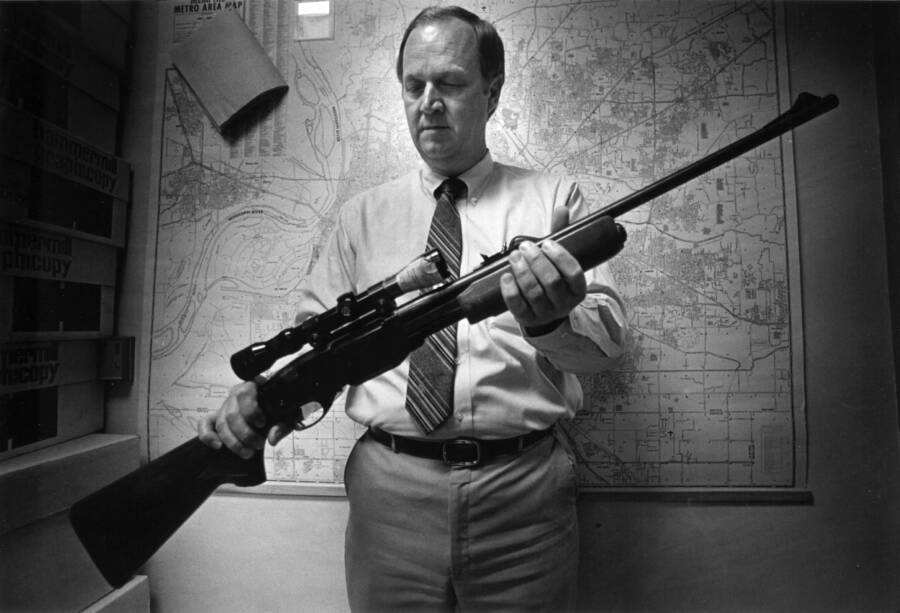
ZUMA Press Inc/Alamy Stock PhotoBen Holley, the supervisor of the state property and evidence room, holds the gun purchased by James Earl Ray.
“I had met with him twice while in Memphis at Jim’s Grill, which was near the boarding house,” Ray later claimed in an interview with The Tennessean. “On the night of the shooting, I had left the rifle with Raoul.”
Ray said he only pleaded guilty because his lawyer and the FBI pressured him into it. Though his story may seem suspect — no one has ever found Raoul — many of King’s loved ones believed he was telling the truth.
“There is abundant evidence of a major high-level conspiracy in the assassination of my husband,” Coretta Scott King, King’s widow, said in 1999. Specifically, she suspected that the FBI played a role in the murder, especially since the organization had harassed King so much.
Did The FBI Kill MLK? Inside Other Theories About His Death
On Dec. 16, 1993, ABC aired an eyebrow-raising episode of Primetime Live, in which a man named Loyd Jowers claimed to have knowledge of a conspiracy behind Martin Luther King Jr.’s murder. Jowers wasn’t just anybody — he was the owner of Jim’s Grill, the restaurant specifically mentioned by Ray as a place where he had met Raoul.
Jowers had spoken to police in 1968. Then, he told them he was working at Jim’s Grill at the time of the assassination. He heard a loud noise, went to investigate, and saw nothing. But in 1993, Jowers changed his story.
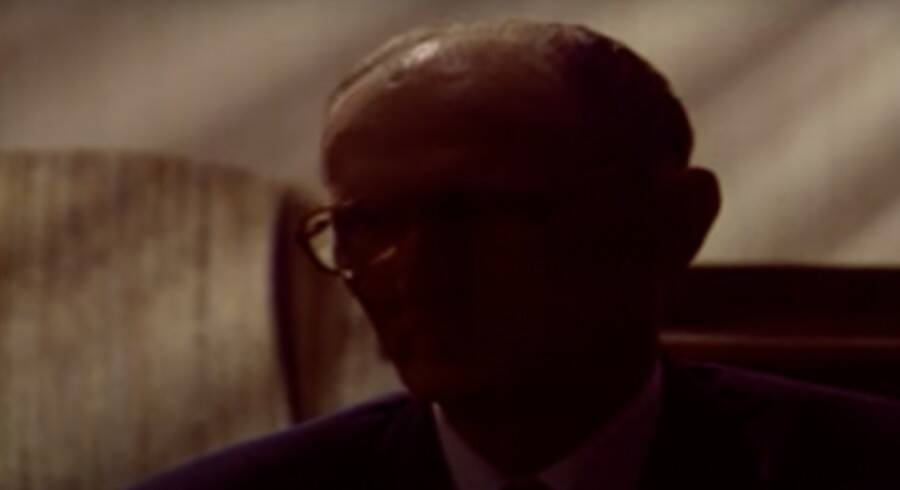
ABC/YouTubeABC obscured Jowers’ face, though they showed his full name.
He then claimed that he had accepted $100,000 from a man named Frank Liberto, a produce merchant who had alleged ties to the Mafia, to “hire someone to assassinate Dr. Martin Luther King.”
Jowers further claimed that James Earl Ray was not the gunman who shot King, and that King’s real assassin was an “African American man.” Later, he alternatively described the assassin as a white “Lieutenant” with the Memphis Police Department, “Raoul,” and another unidentified person.
In 1999, Martin Luther King Jr.’s family brought a wrongful death suit against Jowers. A jury in Memphis unanimously found that Jowers had indeed conspired to kill King alongside “others, including government agencies.”
However, five official investigations into Martin Luther King Jr.’s death came to a different conclusion: They found that King had been killed by James Earl Ray. There is no confirmed evidence that King was killed by the FBI, the Mafia, or any other larger conspiracy. That said, many experts on the topic believe it’s possible Ray had help. After all, pulling off a high-profile murder and an international escape would’ve been difficult to do on his own.
It’s little wonder why many people — including King’s own children — suspect that there’s more to the story of his 1968 assassination.
After reading about Martin Luther King Jr.’s death, discover the stories of civil rights leaders who you didn’t learn about in school. Or, go inside the story of Malcolm X’s assassination with this gallery of tragic photos.





